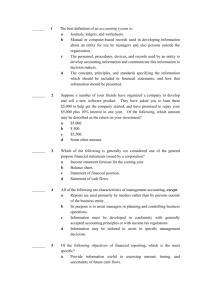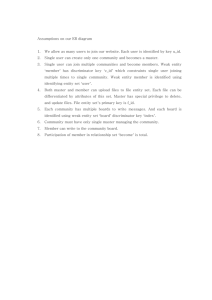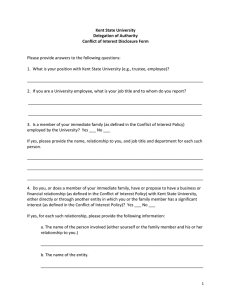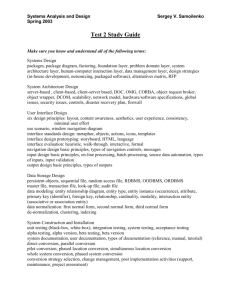Abstract
advertisement
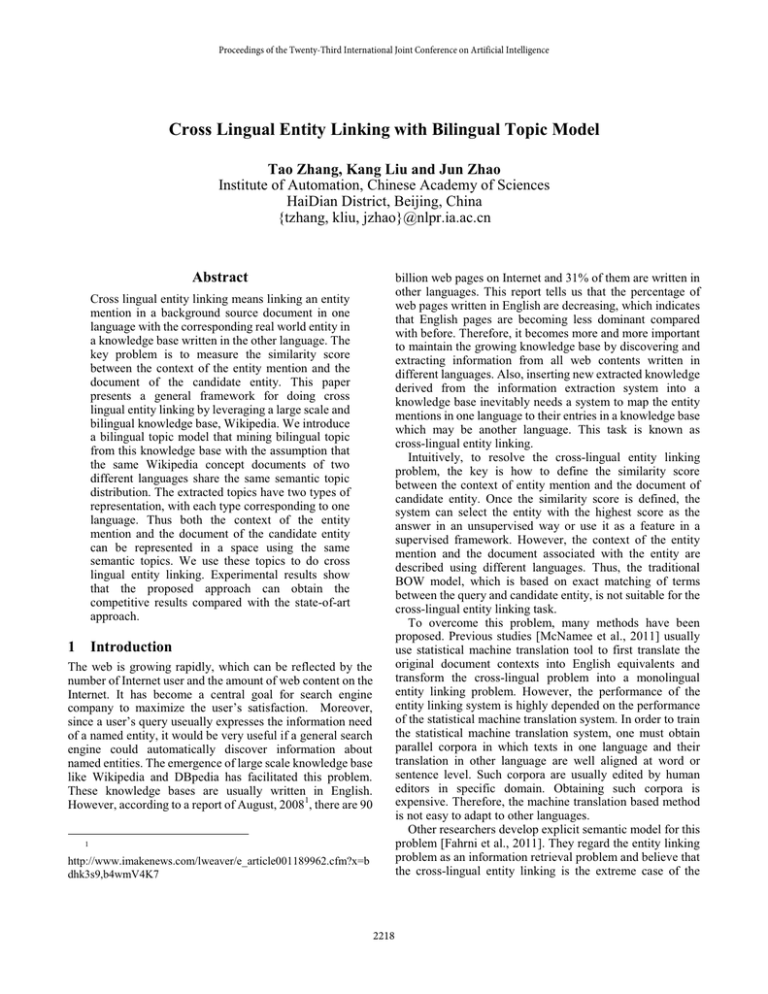
Proceedings of the Twenty-Third International Joint Conference on Artificial Intelligence
Cross Lingual Entity Linking with Bilingual Topic Model
Tao Zhang, Kang Liu and Jun Zhao
Institute of Automation, Chinese Academy of Sciences
HaiDian District, Beijing, China
{tzhang, kliu, jzhao}@nlpr.ia.ac.cn
Abstract
billion web pages on Internet and 31% of them are written in
other languages. This report tells us that the percentage of
web pages written in English are decreasing, which indicates
that English pages are becoming less dominant compared
with before. Therefore, it becomes more and more important
to maintain the growing knowledge base by discovering and
extracting information from all web contents written in
different languages. Also, inserting new extracted knowledge
derived from the information extraction system into a
knowledge base inevitably needs a system to map the entity
mentions in one language to their entries in a knowledge base
which may be another language. This task is known as
cross-lingual entity linking.
Intuitively, to resolve the cross-lingual entity linking
problem, the key is how to define the similarity score
between the context of entity mention and the document of
candidate entity. Once the similarity score is defined, the
system can select the entity with the highest score as the
answer in an unsupervised way or use it as a feature in a
supervised framework. However, the context of the entity
mention and the document associated with the entity are
described using different languages. Thus, the traditional
BOW model, which is based on exact matching of terms
between the query and candidate entity, is not suitable for the
cross-lingual entity linking task.
To overcome this problem, many methods have been
proposed. Previous studies [McNamee et al., 2011] usually
use statistical machine translation tool to first translate the
original document contexts into English equivalents and
transform the cross-lingual problem into a monolingual
entity linking problem. However, the performance of the
entity linking system is highly depended on the performance
of the statistical machine translation system. In order to train
the statistical machine translation system, one must obtain
parallel corpora in which texts in one language and their
translation in other language are well aligned at word or
sentence level. Such corpora are usually edited by human
editors in specific domain. Obtaining such corpora is
expensive. Therefore, the machine translation based method
is not easy to adapt to other languages.
Other researchers develop explicit semantic model for this
problem [Fahrni et al., 2011]. They regard the entity linking
problem as an information retrieval problem and believe that
the cross-lingual entity linking is the extreme case of the
Cross lingual entity linking means linking an entity
mention in a background source document in one
language with the corresponding real world entity in
a knowledge base written in the other language. The
key problem is to measure the similarity score
between the context of the entity mention and the
document of the candidate entity. This paper
presents a general framework for doing cross
lingual entity linking by leveraging a large scale and
bilingual knowledge base, Wikipedia. We introduce
a bilingual topic model that mining bilingual topic
from this knowledge base with the assumption that
the same Wikipedia concept documents of two
different languages share the same semantic topic
distribution. The extracted topics have two types of
representation, with each type corresponding to one
language. Thus both the context of the entity
mention and the document of the candidate entity
can be represented in a space using the same
semantic topics. We use these topics to do cross
lingual entity linking. Experimental results show
that the proposed approach can obtain the
competitive results compared with the state-of-art
approach.
1
Introduction
The web is growing rapidly, which can be reflected by the
number of Internet user and the amount of web content on the
Internet. It has become a central goal for search engine
company to maximize the user’s satisfaction. Moreover,
since a user’s query useually expresses the information need
of a named entity, it would be very useful if a general search
engine could automatically discover information about
named entities. The emergence of large scale knowledge base
like Wikipedia and DBpedia has facilitated this problem.
These knowledge bases are usually written in English.
However, according to a report of August, 20081, there are 90
1
http://www.imakenews.com/lweaver/e_article001189962.cfm?x=b
dhk3s9,b4wmV4K7
2218
vocabulary mismatch problem. To overcome this, they map
texts with respect to the given Wikipedia concepts using ESA
method [Gabrilovich and Markovitch, 2007] and do entity
linking in the space of Wikipedia concept. Multilingual
knowledge base is needed for this method. However, the size
of different knowledge base is different. For example, the
English version Wikipedia in 2009 contains 3,000,000
articles, while the Chinese version Wikipedia only contain
300,000 articles, which is far small from the English version.
This will cause the problem that large percentage of English
Wikipedia concept have no corresponding Chinese concept,
thus influence the performance of the method.
Inspired by the idea of using external data source
mentioned above, we present a general framework for
building cross lingual entity linking system with hidden
topics discovered from large-scale parallel corpora.
Wikipedia, which was launched in 2001, has become a very
big multilingual data resource. In Wikipedia, each article
describes a concept and each concept is usually described by
different languages. The articles written in different language
but describing the same concept are quite related in their
hidden topic. It is interesting to use topic modeling
algorithms to mine cross lingual topics from Wikipedia.
Topic modeling has been widely used by various text
applications [Phan et al., 2008; Titov and McDonald, 2008].
Typical topic modeling methods include LDA [Blei et al.,
2003]. LDA can be seen as a typical probabilistic approach to
latent topic computation. Each topic is represented by a
distribution of words (probabilistic language model) and
each word has a probability score used to measure its
contribution to the topic.
In this paper, we propose a novel bilingual topic model to
modeling bilingual topics from Wikipedia data in two
different languages. A topic is inherently bilingual: each has
two types of representation and each representation
corresponds to one language. The same Wikipedia concept
described by different language follows that constrain of
sharing one identical topic distribution. Based on this
framework, we represent the query and the candidate entity
using as the distribution of semantic topic. The similarity of a
query and an candidate entity is computed as the cosine
similarity between their vectors in the semantic space. This is
illustrated in Figure 1. Experiments on the standard
cross-lingual entity linking dataset show that our approach is
promising. Different from previous research work, our
approach does not require additional linguistic resources like
dictionaries or translation tools. In addition, once the topic
model is estimated, it can be applied to other cross lingual
task provided that they are consistent.
The reminder of this paper is organized as follows. In the
next section we briefly discuss related work on entity linking
task. Section 3 describes our bilingual topic model in detail.
Cross-lingual entity linking is presented in Section 4. We
then present the experimental results in section 5. Section 6
concludes the paper and presents the future work.
Figure 1. Illustration of our proposed method
2 Related Work
The first type of research related to our work is about entity
linking. Many researchers developed entity linking systems
based on the context similarity between the query and the
candidate entities. Various approaches represent different
methods in computing the similarity. Cucerzan [2007]
developed a disambiguation approach based on the
agreement between the contextual information of candidate
entities and the query, as well as the agreement among the
category tags associated with candidate entities. Bunescu and
Pasca [2006] trained a disambiguation SVM kernel on the
Wikipedia data, the similarity between query and candidate
entity was computed based on the SVM kernel, the linking
system thus selected the entity with the highest similarity as
the answer. Han and Zhao [2009] constructed a large-scale
semantic network from Wikipedia, and computed the
similarity between query and candidate entity based on the
constructed semantic network. Radford et al. [2010] applied
a Graph-Based ranking method in their entity linking system,
context entities were taken into account in order to reach a
global optimized solution. Han and Sun [2011] proposed a
generative probabilistic model, which can leverage the entity
popularity knowledge, name knowledge, and context
knowledge for the entity linking task. Other researchers
developed supervised learning approach for the entity linking
task. Milne and Witten [2008] proposed a machine learning
approach to disambiguation that use the links found within
Wikipedia articles for training. The two main features they
used in their classifier were the commonness of each
candidate entity and its relatedness to the surrounding
context. Dredze et al. [2010] employed a learning to rank
method to disambiguate candidate entities. A comprehensive
feature set was used in their system. Zhang et al. [2010]
proposed a method to automate generate a large-scale corpus,
which were used to train a binary classifier. Zhang et al.
[2011] employed a Wikipedia-LDA model to model the
contexts as the probability distributions over Wikipedia
categories and used this model to compute the similarity
between the query and the candidate entities. Such semantic
similarity was considered as an important feature in their
framework. Dai et al. [2011] employed a Markov logic
network in handling this task, but they only conducted
experiments in biomedical domain. Shen et al. [2012]
proposed a system called LINDEN that can leverage the rich
semantic knowledge embedded in the Wikipedia and the
taxonomy of the knowledge base. For cross-lingual entity
linking task, McNamee et al. [2011] use statistical machine
2219
translation tool to first translate the original document
contexts into English equivalents and transform the
cross-lingual problem into a monolingual entity linking
problem. Fahrni et al. [2011] they map texts with respect to
the given Wikipedia concepts and do entity linking in the
space of Wikipedia concept.
The second type of research related to our work is about the
use of topic model in text application. Phan et al. [2008]
utilized the LDA models estimated from Wikipedia to help
classify short text segment. Ni et al. [2011] utilized LDA
models to extract topics from Wikipedia documents and use
these topics to do cross lingual text classification. Titov and
McDonald [2008] present a novel multi-grain topic model for
extracting the ratable aspects of objects from online user
reviews. Similay to our work in [Mimmo et al., 2009], they
propose a polylingual topic model that discovers topics
aligned across multiple languages and demonstrate its
usefulness in supporting machine translation..
3
Finally, the probability of the whole collection
}can be obtained by taking the product of
W={ , ,…,
the likelihood of all single document as follows:
The parameters of LDA can be estimated by directly and
exactly maximizing the likelihood of the whole data
collection. However, exact inference is intractable. The
solution to this is to use approximate estimation methods
such as Variational EM and Gibbs Sampling [Heinrich,
2005]. Gibbs Sampling is a special case of Markov-chain
Monte Carlo (MCMC) and often yields relatively simple
algorithms for approximate inference in high-dimensional
models such as LDA.
Bilingual Topic Modeling
As discussed in the preceding section, our goal is to provide a
method for computing similarity score between the context
of entity mention and the document of an entity in different
languages. We use bilingual topic model method, which
represent document as mixtures of latent topics, to address
this problem. In this section, we will first introduce LDA
briefly. And then, we describe the bilingual topic model and
its estimation method.
3.1 Latent Dirichlet Allocation (LDA)
We will give a brief introduction to Latent Dirichlet
Allocation (LDA). LDA is a generative graphical model as
shown in Figure 2. It can be used to model and discover
underlying topic structure of any kind of discrete data in
which text is a typical example. In LDA, generation of a
collection is started by sampling a word distribution from a
prior Dirichlet distribution dir( ) for each latent topic. Then a
document is first generated by picking a distribution over
topics
from a dirichlet distribution dir( ), which
determines topic assignment for words in that document.
Then the topic assignment for each word is performed by
sampling a topic from topic distribution Mult( ). And finally,
a particular word w is generated from the distribution of
multionmial distribution.
According to the generative graphical model depicted in
Figure 2, the joint distribution of all known and hidden
variables can be written as:
can be
And the marginal distribution of a document
obtained by integrating over
and , and summing over z
as follows
Figure 2. Graphical Model representation of LDA
Figure 3. Graphical Model representation of BLDA
K: the number of hidden (latent) topics
M: the total number of documets
:hyper parameters for Dirichlet distribuation
:topic distribuation for document m
: the length of document m
: topic index of the n-th word in document m
: a particular word in document m
: word distribuation for topic k
: a particular document
Table 1: Notations of LDA
2220
3.2 Bilingual Latent Dirichlet Allocation
In this section, we introduce bilingual Latent Dirichlet
Allocation model. The bilingual LDA model is an extension
of latent Dirichlet allocation (LDA) for modeling bilingual
document tuple. Each tuple is a pair of documents that are
semantically related to each other, but written in different
languages. We assume all documents in a tuple share the
same topic distribution. Also, BLDA assumes that each
“topic” consists of a set of discrete distributions over words,
which corresponds each language. Figure 2 presents the
graphical model of BLDA.
A new document is generated by first drawing a
tuple-specific topic distribution from a Dirichlet prior. Then
for each word in document, a latent topic distribution is
drawn from multinomial distribution. Finally, the observed
word is drawn using the language-specific topic multinomial
distribution. The generation process of BLDA is shown in
Figure 4
For each tuple-specifc topic z, z=1,2,…,K
For each language l
Sample word distribution
For each tuple in a corpus
Sample topic distribution
For each document
in tuple
For each word
in document
Sample topic
from distribution Mult( )
Sample word
from distribution Mult(
3.3 BLDA Estimation
In this section, we will present a modification of Gibbs
Sampling method for the estimation of BLDA.
The first use of Gibbs Sampling for estimating LDA is
reported in [Griffiths and Steyvers, 2004] and a more
comprehensive description of this method is from the
technical report [Heinrich, 2005]. One can refer to these
papers for a better understanding of this sampling technique.
Here, we only show the most important formula that is used
for topic sampling for words. In order to apply Gibbs
Sampling, we need to compute the conditional probability
, where means the vector of all
words in language of the whole data collection D and
denotes the vector of topic assignment except the
considered word at position i in the document item written in
language of tuple m. The topic assignment for a particular
word depends on the current topic assignment of all the other
word positions in the same language. More specifically, the
topic assignment of a particular word t of language is
sampled from the following multinomial distribution:
)
Figure 4. Generation Process of BLDA
From the generative process in Figure 3, we can write the
joint distribution of all known and hidden variables given the
Dirichlet parameters for a specific language j as follows:
Where
is the number of times word t of language j
is assigned to topic k except the current assignment;
The marginal distribution of a document w for a specific
language j can be obtained as follows:
is the total number of words in language
assigned to topic k except the current assignment; and
is the number of words in tuple-unit m assigned to
is
topic k except the current assignment; and
the total number of words in tuple-unit m except the current
word t.
After finishing Gibbs Sampling, we can obtain the
as follows:
multionmil parameter sets and
We can obtain the marginal distribution of a tuple as follows:
4
Where
denotes a tuple document set.
Cross-lingual Entity Linking
Choosing an appropriate document-aligned comparable
training data is extremely important for mining bilingual
topics in bilingual LDA model. The data should large enough
and should balanced distributions over words and topics, and
more importantly, should deal well with the diversity of
Finally, the probability of the whole document collection W
=
is obtained as follows:
2221
future unseen data. In this section, we will empirically
investigate the effectiveness of BLDA for mining bilingual
topics from Wikipedia.
current topics of all the other words in
all words in as follows:
and the topics of
4.1 Hidden Topics from Wikipedia
Today, the growth of the web, and in particular Wikipedia,
has made comparable text corpora-documents that are
topically similar of one another. In our work, we first build a
document-aligned comparable corpus from Wikipedia. We
downloaded XML copies of all Wikipedia articles in two
languages: Chinese, English. The corpus is available at this
address: http://download.wikipedia.org. We preprocessed the
data by removing tables, references, images and info-boxes.
We dropped articles which are written in only one language.
Finally, we got a total of 750M with more than 150,000
parallel Wikipedia articles. This collection covers a lot of
concepts and domains, such as sport, computer science,
internet, business, political and so on. It is reasonable to use it
as a bilingual comparable dataset. Our BLDA model is
general enough and can be easily applied on multilingual
corpus without additional efforts.
We estimated our BLDA models for the Wikipedia data
using JGibbLDA, which is a java implementation of LDA
using Gibbs Sampling. We set the hyper parameters alpha
and beta to be 50/k and 0.1 respectively, where k is the
number of topics. The number of topics ranges from 10 to
150, with 10 as the step size. We estimated the model using
1000 Gibbs Sampling iterations. Figure 5 shows some
example universal-topics produced by BLDA with K=100.
We oberved that the outputs are impressive and satisfy our
exception.
T2:
T2
T14
T14
T25
T25
T43
T43
T64
T64
Where
d except the current assignment;
is the number of words
in d assigned to topic k except the current assignment;
is the number of words in d that are assigned to
is the
topic k except the current assignment;
total number of words in d except the current word t.
After performing topic sampling, the document in any
language can be represented as
, where
each distribution is computed as follows:
4.3 Cross Lingual Entity Linking
The first step in our cross lingual entity linking framework is
to find candidate entity in a Knowledge Base for a given
entity mention. The candidate entity means the entity in the
knowledge base that this entity mention may refer to. We
leverage the knowledge sources in Wikipedia to find
candidate entity, including “entity pages”, “disambiguation
pages”, “redirect pages” and “anchor text”. After obtaining
the candidate entity in one language, we can obtained its
other language form using existing translated link in
Wikipedia. For example, given an entity mention in Chinese
“
(Jordan)”, we can obtain its candidate entity in English
knowledge such as “Michael Jeffrey Jordan”, “Michael I.
Jordan” and so on.
The second step is to define a similarity score for each
candidate entity. Our system selects the candidate entity with
the biggest score as the answer. Even though the document of
entity and the context of the query are written in different
language, we can represent them in the same semantic topic
space using BLDA model. Thus, the similarity score can be
computed by the inner product of their topic distribution
vector.
water chemical carbon gas hydrogen compound element oxygen air energy
(water)
(chemical)
(element)
(gas)
(compound)
Window system computer software user network version microsoft version file
(system)
(version)
(software)
(computer)
(network)
nba team season race championship driver game car club player league won
(race)
(player)
(championship)
(team)
(season)
Music opera instrument musical composer string symphony orchestra piano
(music)
(opera)
(beethoven)
(symphony)
(piano)
freud psychology martial psychoanalysi alsace patient therapy gestalt wundt
(psychology)
(freud)
(spirit)
is the number of times t is assigned to topic k in
(subconsciousness)
Figure 5. Words with highest probability produced by BLDA
4.2 Topic Inference for New Documents
Given a new document in language j, we need to do topic
inference using our BLDA model. Gibbs Sampling is
performed for topic inference, however, the number of
sampling iterations for inference is much smaller than that for
the parameter estimation. We observed that 20 iterations are
enough for topic inference.
Let and be the vectors of all words and their topic
assignment of the document-aligned comparable corpus in
language . And
and are the vectors of all words and
their topic assignment of the new document. The topic
assignment for a particular word in t in
depends on the
5
Experiments and Results
In this section, we evaluate our method in the KBP dataset to
demonstrate the effectiveness of our approach.
5.1 Dataset
In our experiment, the knowledge base is derived from
Wikipedia pages that contain an infobox. It consists of
roughly 818 thousand distinct entities. The KBP 2011 dataset
is used as our test dataset. The dataset contains 2176 queries
and query document come from news wire and Web pages.
Micro-Averaged Accuracy is adopted as the performance
2222
measure in our experiment. It was used in KBP 2011 [Ji et al.,
2011] as the official metric to evaluate the performance of
entity linking.
5.3 Comparison with other state-of-art method
In order to further demonstarte the effectiveness of our
proposed approach, we compared it with other two other
recently proposed methods in KBP 2011. The first approach
[McNamee et al., 2011] is a translation based approach. To
accomplish the cross-lingual entity linking task, they relied
on name transliteration to match the Chinese entities to
English names, and they used statistical machine translation
and cross-lingual information retrieval to transform entity
mention document into English equivalents. The second
approach [Fahrni et al., 2011] is an explicit semantic model
approach. They first build a multilingual knowledge base
from Wikipeida. And then, they use the multilingual
knowledege
base
to
obtain
a
concpet-based
language-independent representation of the entity mention
document and the candidate entity.
Table 2 shows the comparison results of BLDA approach
with translation based approach and explicit semantic model
approach. From the table, we can see that the BLDA
approach outperformes explicit semantic model approach.
This indicates the effectiveness of our BLDA approach.
Althrough the translation based approach gets a slighty better
result than BLDA method, their method need parallel corpora
which are well aligned at word or sentence level. It is
expensive to obtain such parallel corpora.
5.2 Parameters Turning
There are several parameters that need to be determined in
our models. The first is the number of universal-topics. The
second is the number of Gibbs Sampling iterations.
The first experiment is to see how entity linking accuracy
change if we change the universal-topic number.We
estimated many BLDA models for the wikipedia data with
different number of topics (from 10 to 150). The change of
the entity linking accuracy is depicted in Figure 6.We can see
that the optimal results can be obtained with 100
universal-topics. Moreover, the accuracy is quite stable when
the number of topic change from 100 to 150.
BLDA
Explicit semantic model
Translation based method
Figure 6. The effect of the number of universal-topic number
The next experiment is to see how Gibbs Sampling
influences the performance of the entity linking system. We
trained different BLDA models using the Wikipedia data
with different numbers of topics. We ran 1000 Gibbs
iterations to estimate the parameters, and saved the estimated
model at every 200 iterations. At these saving point, we used
the estimaed model to performe topic inference for the entity
mention document and the candidate entity, and then
performed cross-lingual entity linking using their topic
distribuation vector. The results are shown in Figure 7. From
Figure 7, we can see that the performance of the cross-lingual
entity linking system is robust with respect to the number of
different numbers of Gibbs Sampling iterations. Although it
is hard to control the number of Gibbs Sampling iterations,
we found that it yields stable results after 200 iterations.
Micro-Averaged Accuracy
0.792
0.785
0.800
Table 2: comparison with other state-of-art methods
6
Conclusion and Future Work
In this paper, we propose a BLDA model to mine bilingual
topics from Wikipedia to address the problem of
cross-lingual entity linking. Experimental results show that
the proposed method is suitable for discovering bilingual
topic and obtain competitive results on the standard KBP
dataset.
In the future of our work, we plan to investigate the use of
category link structure in Wikipedia and combine it into our
method.
Acknowledgments
This work was supported by the National Natural Science
Foundation of China (No. 61070106, No. 61272332 and No.
61202329), the National High Technology Development 863
Program of China (No. 2012AA011102), the National Basic
Research Program of China (No. 2012CB316300), the
Strategic Priority Research Program of the Chinese Academy
of Sciences (Grant No. XDA06030300), We thank the
anonymous reviewers for their insightful comments.
Figure 7. The effect of the number of gibbs sampling iterations
2223
[Mimmo et al., 2009] D. Mimmo, H.M. Wallach, J.
Naradowsky, D.A. Smith, A.McCallum. Polylingual
Topic Models. In proceeding of ACL, 2009.
[Ni et al., 2011] X. Ni, J. Sun, J. Hu, and Z. Chen. Cross
Lingual Text Classification by Mining Multilingual
Topics from Wikipedia. In proceeding of WSDM, 2011.
[Phan et al., 2008] Xuan-Hieu Phan, Le-Minh Nguyen, and
Susumu Horiguchi. Learning to Classify Short and Sparse
Text & Web with Hidden Topics from Large-scale Data
Collections. In proceeding of WWW, pages 91-100,
Beijing 2008.
[Radford et al., 2010] W. Radford, B. Hachey, J. Nothman,
M. Honnibal and J.R. Curran. Document-level Entity
Linking: CMCRC at TAC 2010. In proceeding of Text
Analysis Conference, 2010.
[Shen et al., 2012] W. Shen, J. Wang, P. Wang and M. Wang.
LINDEN: Linking Named Entities with Knowledge Base
via Semantic Knowledge. In proceeding of WWW, 2012.
[Titov and McDonald, 2008] Ivan Titov, and Ryan
McDonald. Modeling Online Reviews with Multi-grain
Topic Models. In proceeding of WWW, April 21–25,
Beijing 2008.
[Zhang et al., 2010] W. Zhang, J. Su, C.L. Tan and W.T.
Wang. Entity Linking Leveraging Automatically
Generated Annotation. In proceeding of Coling, pages
1290-1298, 2010.
[Zhang et al., 2011] W. Zhang, J. Sun and C.L. Tan. A
Wikipedia-LDA Model for Entity Linking with Batch
Size Changing Instance Selection. In proceeding of
IJCNLP, pages 562-570, 2011.
References
[Blei et al., 2003] David M. Blei, Andrew Y. Ng, and
Michael I. Jordan. Latent Dirichlet Allocation. Journal of
Machine Learning Research, 993-1022, 2003.
[Bunescu and Pasca, 2006] R. Bunescu and M. Pasca. Using
Encyclopedic
Knowledge
for
Named
Entity
Disambiguation. In proceeding of EACL, pages 9-16,
2006.
[Cucerzan, 2007] S. Cucerzan. Large-Scale Named Entity
Disambiguation Based on Wikipedia Data. In proceeding
of EMNLP, pages 708-716, 2007.
[Dredze et al., 2010] M. Dredze, P. McNamee, D. Rao, A.
Gerber and T. Finin. Entity Disambiguation for
Knowledge Base Population. In proceeding of Coling,
pages 277-285, 2010
[Dai et al., 2011] H. Dai, R.T. Tsai and W. Hsu. Entity
Disambiguation Using a Markov-logic Network. In
proceeding of IJCNLP, pages 846-855, 2011.
[Fahrni et al., 2011] Angela Fahrni, and Michael Strube.
HITS' Cross-lingual Entity Linking System at TAC 2011:
One Model for All Languages. In proceeding of Text
Analysis Conference, November 14-15, 2011
[Gabrilovich and Markovitch, 2007] E. Gabrilovich and S.
Markovitch. Computing Semantic Relatedness using
Wikipedia-based Explicit Semantic Analysis. In
proceeding of IJCAI, pages 1606-1611.
[Griffiths and Steyvers, 2004] T. Griffiths and M. Steyvers.
Finding scientific topics. The National Academy of
Sciences, 101:5228–5235, 2004.
[Han and Zhao, 2009] X. Han and J. Zhao. Named Entity
Disambiguation by Leveraging Wikipedia Semantic
Knowledge. In proceeding of CIKM, pages 215-224,
2009.
[Han and Sun, 2011] X. Han and L. Sun. A Generative
Entity-Mention Model for Linking Entities with
Knowledge Base. In proceeding of ACL, pages 945-954,
2011.
[Heinrich, 2005] G. Heinrich. Parameter estimation for
text analysis.Technical report, 2005.
[Ji et al., 2011] Heng Ji, Ralph Grishman, and Hoa Dang.
Overview of the TAC2011 Knowledge Base Population
Track. In proceeding of Text Analysis Conference,
November 14-15, 2011
[McNamee et al., 2011] Paul McNamee, James Mayfield,
Veselin Stoyanov, Douglas W. Oard, Tan Xu, Wu Ke,
and David Doermann. Cross-Language Entity Linking in
Maryland during a Hurricane. In proceeding of Text
Analysis Conference, November 14-15, 2011
[Mline and Witten, 2008] D. Milne and I.H. Witten. Learning
to Link with Wikipedia. In proceeding of CIKM, pages
509-518, 2008.
2224
